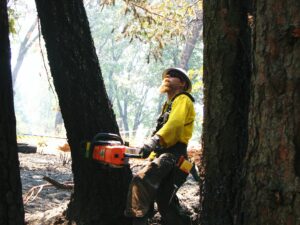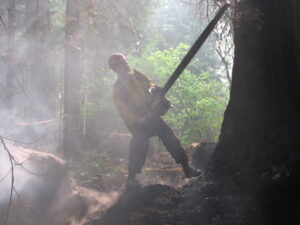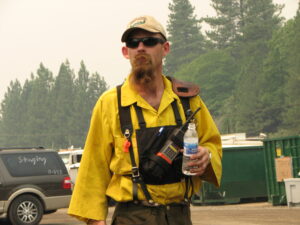The Logging Accident
by Marc Hitson
Logging is a dangerous sport/trade, especially for timberfallers, so I wanted to share this Shane story. I worked with him on my first fire- he was an Idaho cowboy who had turned timberfaller. One off season he went to Alaska to work in the woods in the big spruce up there on the coast Islands where it rains a lot. I heard from our boss later that winter that Shane had been in a horrible logging accident.
He was at the Fire Safety class the next year and I got the first hand story from Shane himself (and he gladly regaled me with it). First, I was surprised and happy to see him walking and at the class, as it had been reported that he might not be able to work on the leg again, but Shane successfully passed the one mile light pack test with the whole class rooting for him. He does have a lot of spirit, the young lad does.
The setting:
The Alaskan coastal islands get an absurd amount of rain and the trees, especially spruce, grow quite large and tall. They can be 15 feet in diameter and two to three hundred feet tall, and an average big tree (over 6 feet in diameter) would weigh around a million lbs.
The ground is steep and uneven making the ideal lay for the tree to avoid excessive breakage to be straight up the steep slope and this presents unusual safety issues for the workers.
The trees grow faster than many other species in the area and form some unwanted swelling at the stump. The faller must manufacture some scaffolding from materials at hand in order to perform felling operations above the unwanted swelled stump area which he does mainly by conscripting smaller trees close by and using his chainsaw to cut short slabs approx. 1 foot by 4 feet by 2 inches thick. He then bores into the stump cutting a notch for the end of the slab to be inserted into forming a stepping board to stand on while performing his tree felling operations. Many such boards would be used on a tree this size.
Also, for safety reasons, the fallers work in pairs in order to have a buddy at hand in case of an injury while working this dangerous job. Of course it pays well to those brave souls willing to take the chances such as a somewhat wild Idaho cowboy in this case.
Well, as the story goes, one of Shane’s co-workers, Dave, had a close call while they were both falling timber up in Alaska on a helicopter logging show for Columbia Helicopters. Dave was falling a tree up the slope on a steep hill. In his mind he could see that the weights and lever forces involved were going to cause the tree to rock over a fulcrum up the hill, which was a rock outcropping, and the base of the tree was going to fly up in the air from the stump and then the force of gravity would pull the whole tree straight down the hill like a freight train. He could easily imagine this scenario in his minds eye.
As a faller, one’s survival depends on accurate assessments of extreme forces involving hundreds of tons of weight, the effect of gravity on the steep ground and properly devising a strategy of escape to safety. Flight speed is a very important element of the escape to safety.
To stay safe the faller does his best to establish where a safety zone might be and then devise a scheme of getting there in the three to 8 seconds the tree takes to fall. You can see that the survival skills of a logger include the implementing of real life engineering skills regarding what-if scenarios, and one’s accurate predictions of action/reaction. A lot of thought and reflection on previous experience goes into the planned execution of felling prior to the epic reactions which commence once the tree is released from the stump and the several hundred tons are committed to the forces of gravity.
Well, Dave’s what-if analysis turned out to be very accurate but he missed something. The one thing that can cause a slip up might be the least little factor, such as constant rain and mud causing one to slip during the escape route.
Perhaps he was getting pushed for production and failed to prepare adequate footing because he somehow overlooked the slippery situation in the mud and constant rain. As he attempted to make it to safety, Dave slipped and slid below the stump himself as the tree was falling and it popped off the stump and slid backwards directly towards him. Having made this mistake myself before, I can imagine the feeling of helplessness he must have felt watching it all unfold from the unsafe position of being underneath the falling/sliding tree. He had time to crab walk on all fours a step or two sideways which may have saved his life. A limb caught Dave’s clothes and pulled him down the hill at a high rate of speed as he bounced along the ground like a rag doll.
He was so traumatized by this event that he went to the bosses and quit immediately. The problem is, it takes awhile to quit in Alaska, as the boat ride out only happens on specified occasions, so the supervisors asked Shane to fall for Dave, and Dave would take the responsibility of 2nd faller and “bucker” so he could work. This arrangement was satisfactory to both men – Dave, who was done with falling, and Shane who liked to fall.
Thus the story begins. Shane was falling a 7′ diameter Spruce for Dave to “buck”, or cut into short logs that the helicopter could lift. Shane was using an  066 Stihl with a 54″ bar and chain to cut the big tree which must have weighed around 500 hundred tons (according to a spruce density calculator I found). There is so much rain in Alaska that the trees on the coast and the islands grow very fast and with misshapen stumps and roots and the big Spruce that Shane was cutting had roots flaring out so that he had to ‘springboard’ up to a height of around 6 to 10 feet to get to where the main trunk of the tree began and where the wood was suitable for the felling procedures. Shane had several of these springboards inserted so that he could walk around the back of the big Spruce while sawing several feet above the ground.
066 Stihl with a 54″ bar and chain to cut the big tree which must have weighed around 500 hundred tons (according to a spruce density calculator I found). There is so much rain in Alaska that the trees on the coast and the islands grow very fast and with misshapen stumps and roots and the big Spruce that Shane was cutting had roots flaring out so that he had to ‘springboard’ up to a height of around 6 to 10 feet to get to where the main trunk of the tree began and where the wood was suitable for the felling procedures. Shane had several of these springboards inserted so that he could walk around the back of the big Spruce while sawing several feet above the ground.
The trees that big can be around 300 feet tall. Shane is a good faller and has no trouble making the tree go where he wants it to go. When the undercut, or “directional face cut” was installed he began the final “back cut” to release the tree from the stump, taking care to leave the uncut strap of wood across the diameter of the stump which allows the faller to control the direction of the fall. As the tree begins to tip over, slowly at first, the faller must keep up with the sawing of stump wood to keep control and prevent unwanted splitting or “pulling of slivers”. Shane was worried that the tough spruce would pull up a root out of the ground which could dislodge the springboard he was standing on. As the tree started going faster and having properly cut up to the control strap, or “hinge.” Shane turned off his saw and set it up on the stump in the ever faster opening cut and concentrated on keeping his footing on the spring boards. The tree hit the ground with all its length and weight with a spectacular crash, taking out smaller trees and squashing down the underbrush. He took a moment to appreciate the majestic forces he had just witnessed. The vibrations dislodged a fallen tree upslope. Shane said he heard something and turned around to see the tree coming but it was already on him and pinned his leg to the stump high in the air.
He ended up hanging upside down by his pinned leg. He could just barely reach up and get his fingers on the stump and pull himself up so he was sitting on the stump of the Spruce tree, still pinned. By this time he was yelling for Dave who came running with his saw. Shane wanted Dave to cut him loose to get the tree off his leg. Dave didn’t want to do it as he was afraid the tree would slide on down the steep hillside and crush Shane once he cut it in half. Shane had to get himself under control, calm down and quit yelling and tell Dave how he wanted him to do it. Dave still had doubts. Shane yelled that he didn’t care, just do it, so Dave did and it worked.
Shane told me as he was relating the story that it wasn’t that he was correct in assessing it but just that he didn’t care at that point he wanted that tree off him. He checked his leg and realized it was pretty bad – his foot was backwards and hurt real bad. He pulled his foot around and it felt better. He started to take his boot off but Dave said, “No, it would be better to leave it on”. He radioed the helicopter logging crew and the logging operations were immediately shut down while men and rescue helicopters were mobilized.
They had to pack Shane down to a clearing area where the helicopter would have access. It came in with a “long line” and a basket where he was loaded into the basket and tied in. When he was being loaded into the basket it was too small, and the helicopter was not equipped with a splint so the man on the ground loading him had to fold the leg back in an unnatural position and strap him in which did more damage. It hurt. They gave him morphine, and it still hurt. They gave him more until they were all out.
Shane was flown to the log landing area where they put him down in the basket, landed the helicopter, put him inside and flew to a hospital in Ketchikan. Shane spent the next 10 days in Ketchikan on pain drugs and he said it is mostly a blur – he doesn’t remember it much.
His leg became swollen and the circulation was bad and they were talking about amputation. Because of the swelling they could not put it in a cast or set the bone. Finally they decided to send him to Bend, Oregon where specialists performed operations to restore circulation. They could not set it for the first three months and Shane showed me two big scars on either side of his calf about 3” wide and a foot long. I observed that it looked like it probably took all the skin off his butt to patch that, and he said, “No”, they took it off his thigh and that hurt pretty bad in itself. He ended up with a titanium rod in his leg. They still were talking about amputation for awhile and it was touch and go but he was young and kept healing up.
That’s pretty much the story. He is now able to limp along and has been talking about going back to work. Whew! That story was an adrenalin rush just to write about and to picture! Loggers!

Great story Mark! I spent the first six years of my career as a field sale layout forester on Prince of Wales Island, Suemez Island and Metlakatla Indian Reservation in S.E. Alaska. You nailed it with your description of the working conditions and hazards of the profession. The biggest tree that I cruised during my career in Alaska was on Suemez Island and was 100 inches DBH. It took the faller over an hour to perform his perfection to safely bring that tree down. It had over 10,000 board feet in the tree. It was a monster.
I gained so much respect for these fallers, choker setters, and all the young men working in these extremely dangerous conditions. I saw the need for cork boots walking on these slimy logs and the reason that I wanted to assist you with the Job Hazard Analysis on the 2018 Oregon fire that I had the pleasure of meeting you.
Stay safe out there!! Safety first!!
It was and is much appreciated, Robert, Thanks. This story told to me by Shane grabbed me and I had to do my best to tell it.